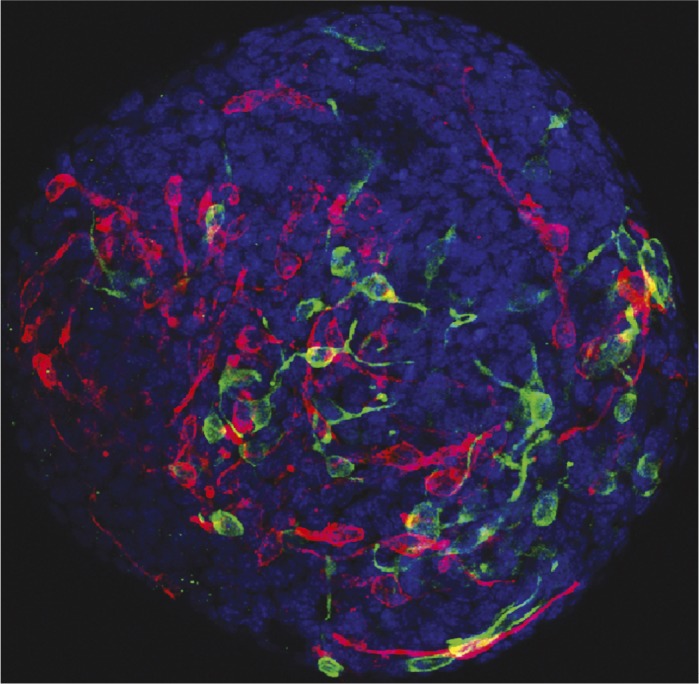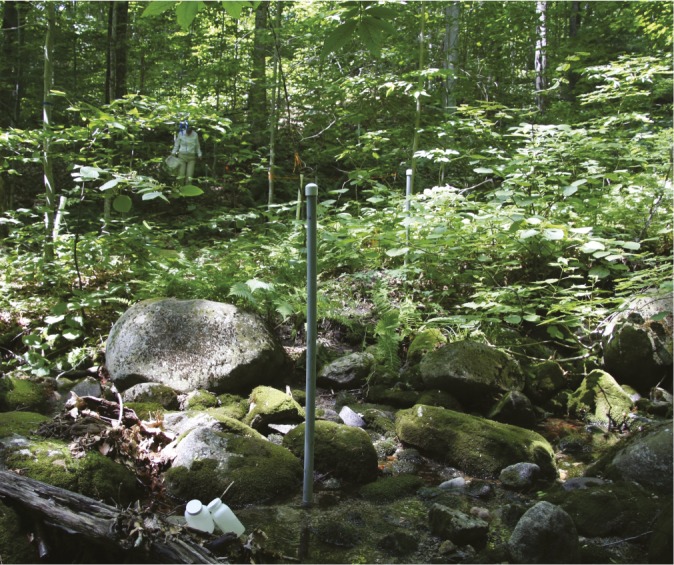Taste bud cell regeneration

Two types of mature taste receptor cells (pink and green) within an organoid (blue).
Leucine-rich repeat-containing G protein coupled receptors (Lgr) are common biomarkers of stem cells found in many adult tissues, and some studies indicate that Lgr5 is expressed in stem cells located at the back of the tongue that differentiate into taste cells. Wenwen Ren et al. (pp. 16401–16406) investigated Lgr5- and Lgr6-expressing stem cells harvested from mouse tongues to explore the ability of the cells to regenerate taste tissue. The authors found that when single cells expressing Lgr5 or Lgr6 were grown in vitro, the cells produced several proteins indicative of cell proliferation and divided into 3D structures termed organoids, which contained all three types of mature taste receptor cells: type I glial-like cells, type II receptor cells, and type III presynaptic cells. The mature taste cells within the organoids responded to taste stimuli, demonstrating their functionality. Both anterior and posterior tongue tissue from the mice expressed Lgr5 and Lgr6, suggesting that the protein may serve as a biomarker for taste stem cells in both areas of the tongue. According to the authors, single Lgr-expressing cells possess the ability to generate mature taste cells ex vivo without a blood or nerve supply. — J.P.J.
Life purpose and healthcare-seeking behavior
Pursuing a goal-driven existence is associated with better health, but few researchers have explored the relationship between life purpose and patterns of healthcare use. In a study of 7,168 Americans, Eric Kim et al. (pp. 16331–16336) found an association between strong life purpose and heightened interest in preventive healthcare services and reduced hospitalization. The authors performed a 6-year study of participants from the Health and Retirement Study, a nationally representative panel of American adults over the age of 50. After adjusting for sociodemographic factors, the authors found that each unit increase in purpose on a six-point Likert scale reflected a progressively higher likelihood that participants would obtain a cholesterol test or colonoscopy, but not a preventive flu shot. Women with high scores were more likely than others to receive a mammogram/X-ray or pap smear, whereas men with high scores were more likely than others to receive a prostate exam. The study further revealed that each unit increase in purpose was associated with 17% fewer nights spent in the hospital. According to the authors, the findings may inform strategies to increase the use of preventive health care services and enhance the quality of life among people moving into the ranks of aging American society. — A.G.
Gut bacteria and human evolution
The communities of microorganisms inhabiting the human body, known as the microbiome, are influenced by host genetics, lifestyle, and environment. Yet a lack of knowledge of the microbiomes of apes hampers understanding of how the human gut microbiome has changed since the human–chimpanzee split during evolution. Andrew Moeller et al. (pp. 16431–16435) sequenced the V4 region of 16S ribosomal DNA from fecal samples of 416 wild great apes, including chimpanzees from Tanzania, bonobos from the Democratic Republic of Congo, and gorillas from Cameroon. The authors compared the sequence data with corresponding data from 638 humans living on three continents and with four different lifestyles: hunter-gatherer, preindustrial, rural, and urban. A phylogenetic approach to reconstructing the evolution of present-day human microbiomes suggested that the human microbiome changed at an accelerated rate, compared with the African ape biome. Relative to the microbiomes of wild African apes, human microbiomes showed decreased diversity of gut bacteria and increased numbers of bacteria associated with an animal-based diet. This decrease in human microbial diversity relative to that of wild apes was seen in all the human populations tested, suggesting that the diversity of gut bacteria has decreased over the course of human evolution, according to the authors. — L.G.
Denitrification in hillslope groundwater

Sampling stream water and shallow groundwater in Hubbard Brook watershed 3, summer 2011. Image courtesy of Kristin Waeber (photographer).
Denitrification, the process of converting nitrate to nitrogen gas, is difficult to quantify in forest watershed ecosystems; as a result, forest nitrogen budgets are unbalanced. Sarah Wexler et al. (pp. 16413–16418) measured stable isotopes of oxygen and nitrogen in nitrate throughout the lower reaches of a watershed in the Hubbard Brook Experimental Forest in New Hampshire. Atmospheric nitrogen deposition adds 6–8 kg of nitrogen per hectare per year to the watershed, but streams carry away less than 1 kg per hectare per year. Although stream water isotopic signatures displayed no sign of denitrification, shallow perched patches of groundwater on hillslopes, which displayed little hydrologic connection to streams, showed evidence of high rates of denitrification during midsummer. Examining the sources of nitrate in streams, the authors found that up to 34% of the stream nitrate may have originated in precipitation, suggesting that streams can export atmospheric nitrate during summer rainstorms and not only during snowmelt, as previously observed. The results suggest that transient perched patches of groundwater may provide an overlooked hotspot for denitrification in forest watersheds, according to the authors. — P.G.
Connectome mapping and diffusion MRI tractography
Numerous studies have used tractography based on diffusion-weighted MRI (DWI) to help create a comprehensive map of structural connections in the human brain. But such attempts are currently hampered by technical limitations that affect in vivo data acquisition. Cibu Thomas et al. (pp. 16574–16579) applied advanced tractography methods to an ex vivo DWI data set of the macaque brain and compared the results with maps of known axonal projections in the macaque that were generated by tracer studies. Despite the high quality of the DWI data, the authors found that none of the investigated tractography methods yielded highly accurate maps of anatomical connectivity, and that all the methods exhibited marked trade-offs between sensitivity and selectivity. Furthermore, anatomical accuracy depended strongly on tractography parameters, requiring different optimal values for different pathways. Noting that diffusion MRI remains an important, non-invasive tool for evaluating brain tissue microstructure and white matter architecture, the authors note that DWI tractography may be inherently limited and insufficient to create an anatomically accurate map of the human connectome. — T.J.
Modeling human population growth
Population control is a frequently proposed solution to increasing natural resource consumption and ecosystem erosion. Corey Bradshaw and Barry Brook (pp. 16610–16615) examined the influence of population reduction scenarios on global population size using a model based on demographic data from the World Health Organization and the US Census Bureau. Under current conditions of fertility, mortality, and mother’s average age at first childbirth, the model predicted growth of the global population from 7 billion in 2013 to 10.4 billion by 2100. Climate change, war, decreased mortality and fertility, and increased maternal age at first childbirth exerted small influences on the baseline scenario. Catastrophic global pandemic scenarios resulting in the deaths of 2 billion or 6 billion people were projected to reduce population size to 8.4 billion or 5.1 billion people, respectively. Mandated one-child limits were projected to return the global population to the 2013 level by 2100, whereas such a policy with no decrease in 2013 mortality rates would yield a 2100 population size of more than 3.5 billion. According to the authors, large reductions in the global human population are unlikely in the next century, and efforts to preserve ecosystems and natural resources should focus on improved technological and social innovations in addition to effective population policy. — J.P.J.


